The content of the article
Such a conventionally edible mushroom as a spider web purple is not often found in the forests of our country, which is not surprising, because it is listed in the regional and federal lists of endangered species, as well as in the Red Book. It received its name for its distinctive, very bright and saturated color, in which both its hat and leg are painted. Usually, screaming appearance in nature is a real synonym for danger - it suffices to recall such a poisonous mushroom known to all from childhood as the red fly agaric. But, then, they are the rules, so that there are exceptions to them - in this case, the role went to the spider web purple, more details about which you will find in this article.
Description
The cobweb violet (in the scientific Latin language known as Cortinarius violaceus) is an inedible and conditionally edible mushroom, which is possible, but with great care and only as a last resort.In any case, it is not recommended to do this, because the mushroom is not only very interesting and beautiful, but, moreover, also unusually rare, as indicated by the fact of its official entry in the Red Book. And certainly you should not hunt him specifically.
The plates in the wrong part of the cap are rather thick and wide, rarely located, having dark purple at first, and then, at the time of spore aging, a violet brown color. Young specimens at the bottom of their caps have a web-like tender white veil.The taste of the fungus is neutral, the same can be said about its smell - it is almost completely absent. The flesh can be described as soft and brittle, colored in violet, bluish or violet-gray. With age, it fades, gradually becoming whitish.
The leg of the fungus, equipped with the remains of a spider bedspread, is also painted in violet or brown violet, with a lighter shade to the base. Made in the form of clubs with longitudinal fibers, depending on the age and growing conditions of the environment, it reaches a width of 10-20 mm, and a height of 60-120 mm.
Spread
On the territory of our country, such a rare and disappearing conditionally edible mushroom, like the purple spider web, most often grows in coniferous and deciduous forests. In the northern zone of the temperate climate, it can be found in a state of symbiosis with the roots of the usual trees - pine and spruce, birch and oak, beech and many others. There is a mushroom not only in Russia, but also in many foreign areas located in the expanses of North America, Europe or Japan.
The maturation of this species of spider web occurs in a transitional period, from summer to autumn, usually taking place in late August and early September. The fungus readily settles on mossy soil, sour and humus soil, so the chances of stumbling across it near the marsh are much higher than meeting it in the middle of the forest edge. Spiderweb purple grows in different ways, both in a stand-alone form and as part of small groups, usually choosing the roots of coniferous or deciduous trees as their “home”.
Similar species
Despite the fact that such a characteristic, bright and saturated purple color is found among the common mushrooms in our country is not so often, there are at least two species similar to this type of cobweb - edible amethyst varnish, also known as lilac, and conditionally edible purple Rowing These two mushrooms can be eaten after boiling thoroughly in boiling water.
In addition, in nature there are some species similar in color to the spider web, painted in a wide range of shades, from mauve to blue - they are inedible, though they are not poisonous at the same time.It is quite simple to distinguish a real purple spider web from them - for this you need to carefully look under the cap - the plates should have the same color as the rest of its surface, and either a spider-like coverlet or its remnants should be on top. Another distinctive feature is a well-marked belts located around the legs.
Eating
Can I eat a purple spiderweb? Can,but where it would be more correct to simply take a picture of this beautiful and extraordinary creation of nature as a keepsake, and pass by - perhaps by doing so you will help him not to disappear altogether. Sometimes nature throws up really interesting and interesting riddles to a person like this one, which stands out with a bright spot against the background of a plain green picture of a forest. Typically, these colors cause well-justified concerns of mushroom pickers - perhaps it is this color that will be a salvation on the way to complete extinction?
Video: purple cobweb (Cortinarius violaceus)












To send